January 8, 2024 feature
This article has been reviewed according to Science X's editorial process and policies. Editors have highlighted the following attributes while ensuring the content's credibility:
fact-checked
peer-reviewed publication
trusted source
proofread
Scientists create DNA hydrogel-based, solar-powered evaporation system for highly efficient seawater desalination
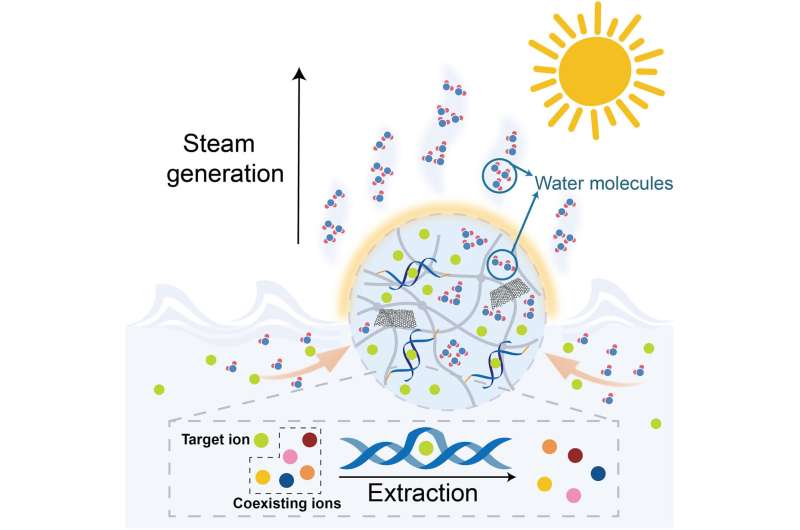
Minerals as well as freshwater can be obtained by desalinating seawater with solar power facilities for the sustainable development of human civilization. For instance, hydrogels have shown great power for solar-powered water evaporation potential, although the highly efficient and specific target extraction method remains to be expanded.
In a recent report published in Science Advances, Hanxue Liang and a team of researchers at the college of chemistry, and materials science in China, describe the process of highly efficient seawater desalination and the specific extraction of uranium with smart DNA hydrogels.
The DNA hydrogels promoted the evaporation of water, and the uranyl-specific DNA hydrogel exhibited a high capture capacity of 5.7 mg per gram for uranium from natural seawater due to rapid ion transport driven by solar-powered interfacial evaporation and high selectivity. These developments could enable easy-to-use devices suited for future seawater treatment.
Seawater desalination
Human society can be developed sustainably through access to sufficient freshwater and energy. The past few decades have witnessed the growing scarcity of freshwater as a threat to developing society, where rapid population and economic growth too have posed challenges to sustainable development.
To facilitate access to freshwater, life scientists have used ocean resources such as seawater desalination to account for up to 97% of the total water content on Earth.
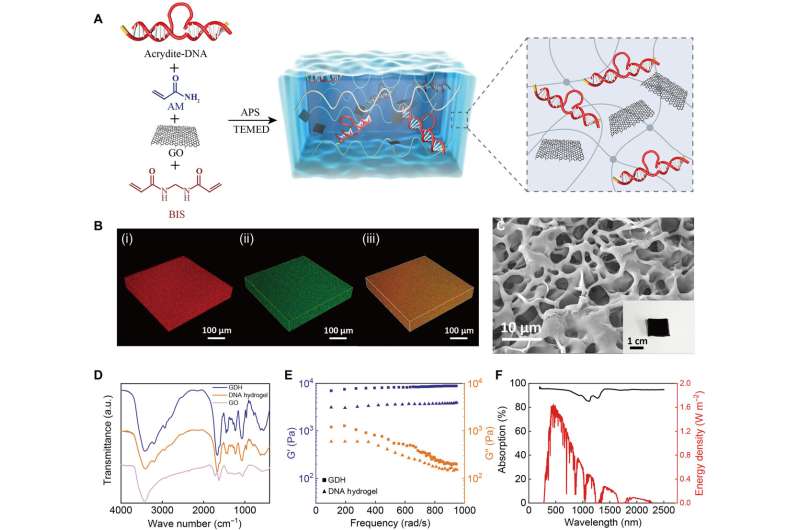
Researchers have developed solar-powered seawater desalination as a promising method to produce seawater without additional energy consumption. Alongside desalination of seawater, a variety of valuable minerals and resources rich in the ocean can be extracted simultaneously, including uranium and lithium.
Hydrogels are soft materials made of hydrophobic 3D crosslinked polymer networks with high quantities of water, with a soft unique nature, versatility, and excellent biocompatibility.
Water evaporation
Hydrogel-based biomaterials have an ultrahigh water evaporation rate. In this work, Liang and team created a DNA hydrogel-based, solar-powered evaporation system to produce freshwater and target metal ion extraction from natural seawater. The scientists synthesized DNA hydrogels made of functional DNA-tethered polyacrylamide networks through a one-step copolymerization process.
The researchers introduced graphene oxide (GO) into the hydrogel to create GO-loaded DNA hydrogels that were easily recycled by a simple, thermally-driven elution method to test the feasibility of producing freshwater, and to extract valuable metal ions from natural seawater.
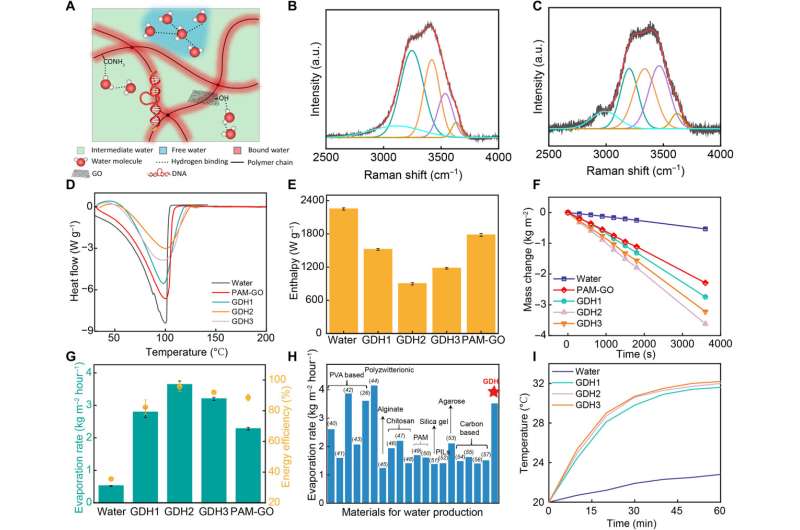
Characterizing the graphene-oxide-loaded DNA hydrogels (GDH)
Liang and colleagues prepared the graphene-oxide loaded DNA hydrogels in a one-step copolymerization reaction by using acrylamide, N,N'-methylenebisacrylamide, acrydite-modified DNA, with graphene-oxide added before polymerization.
The researchers applied confocal microscopy to investigate the microstructures of the as-prepared materials. The team noted the improved mechanical properties of the DNA hydrogel upon introducing graphene oxide. The addition of the compound into the DNA hydrogel enabled highly efficient solar light-absorbing properties. The materials showed broadband and a highly efficient absorption wavelength range.
The experiments
The research team explored the competence of the biomaterials for highly efficient solar-powered water evaporation. Where the materials formed hydrogen bonds with hydrophilic polymer chains to confine water molecules within a hydrophilic hydrogel construct.
The process led to the formation of three types of water molecules, including free water, intermediate water, and bound water, where the process required less energy for intermediate water to escape the hydrogel than for free water to transit from the bulk liquid phase.
Hydrophilic groups in the material facilitated the activation of water molecules and reduced the evaporation energy of water by regulating the hydrogen bonding structures of encapsulated water molecules. The researchers used Raman spectroscopy to differentiate varieties of water structures in pure water and within the hydrogel material.
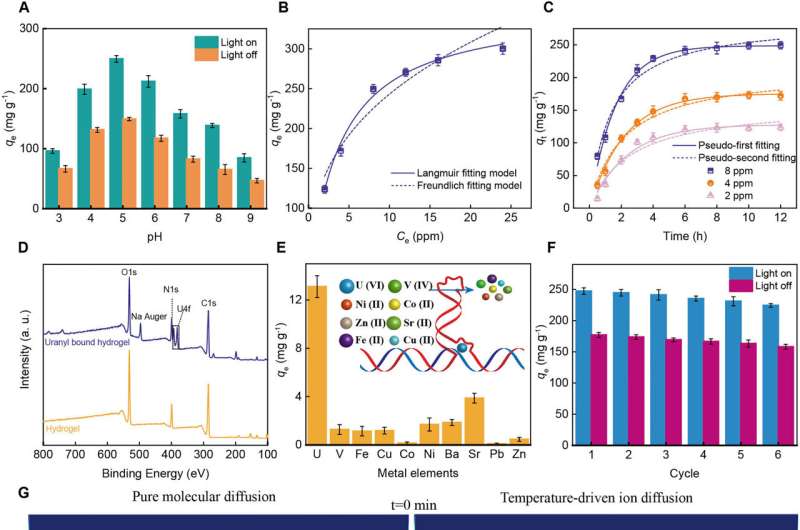
Graphene-oxide loaded DNA hydrogels to extract uranium
Uranium is distributed in oceans as a key element in nuclear fuels with magnitudes of abundance when compared to land. The main form of uranium in seawater is uranyl ions, with a low concentration, where the elements coexist with many interfering ions including vanadium.
DNAzymes or catalytic DNA that contains short DNA oligonucleotides can extract rare metal ions such as uranyl ions, due to their high affinity and specific metal ion binding properties.
To facilitate the process, the team encoded the DNA units that were incorporated into the graphene-oxide hydrogel with the sequence of uranyl-selective DNAzyme to extract the uranyl ions. The control experiments showed how the hydrogel without DNA had a much lower uranium adsorption capacity.
The biomaterial was also capable of selectivity for uranium in the presence of vanadium ions, and the incorporation of DNA provided a key for selectivity with uranium adsorption. The outcomes outlined the wide range of anti-biofouling activity of the biomaterial for long-term applications in seawater desalination and during uranium extraction.
Further experiments and extracting uranium from natural seawater
Liang and team performed numerical simulations to compare the migration of ions through diffusion, and noted the presence of a temperature gradient upon illumination. The temperature gradient increased the transport of ions to promote the process in the entire hydrogel construct.
The DNA units in the biomaterial selectively extracted diverse targets to establish a lithium ion-dependent DNAzyme, as well as sodium, potassium, and magnesium metal ion extraction with smart DNA hydrogels.
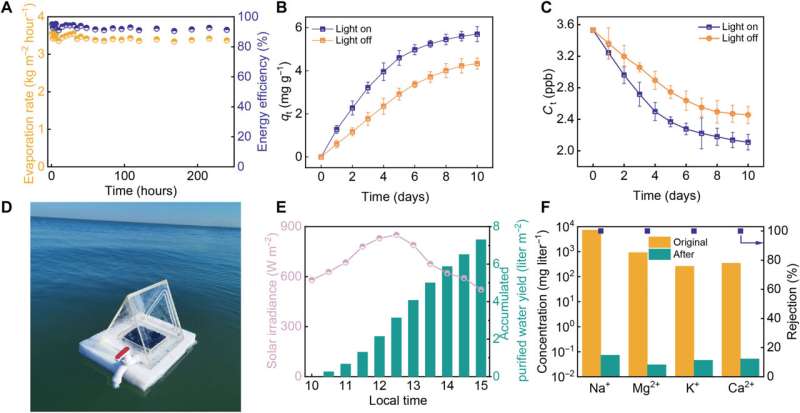
While the graphene-oxide loaded DNA hydrogel biomaterial showed excellent capacity for uranyl extraction from natural seawater, the extraction capacity increased under solar illumination in an endothermic process. The uranium extraction performance with the biomaterial was as competent as that obtained with advanced extraction materials.
Liang and team tested the performance of the biomaterial with natural seawater via inductively coupled plasma optical emission spectroscopy in the Bohai sea. The outcomes showed the capacity to simultaneously evaporate water ultrafast and highly selectively from natural seawater with the solar-powered biomaterial-integrated device.
Outlook
In this way, Hanxue Liang and team invented a DNA hydrogel-based, solar-powered evaporation system to simultaneously facilitate high-speed seawater desalination and highly specific extraction of minerals including uranium and lithium. The highly hydrophilic network structures facilitated water evaporation enthalpy in the hydrogel to effectively promote solar-powered seawater evaporation.
The team introduced DNA structures to improve the evaporation efficiency of the platform and facilitated the hydrogel with specific metal ion extraction properties for metal ion extraction under illumination. The smart DNA hydrogels are promising for freshwater harvesting and uranyl extraction from seawater, and for uranyl-enriched nuclear wastewater treatment.
More information: Hanxue Liang et al, Solar-powered simultaneous highly efficient seawater desalination and highly specific target extraction with smart DNA hydrogels, Science Advances (2023). DOI: 10.1126/sciadv.adj1677
© 2024 Science X Network















